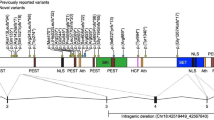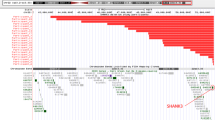Abstract
Speech and language impairments are central features of CDK13-related disorder. While pathogenic CDK13 variants have been associated with childhood apraxia of speech (CAS), a systematic characterisation of communication has not been conducted. Here we examined speech, language, non-verbal communication skills, social behaviour and health and development in 41 individuals with CDK13-related disorder from 10 countries (male = 22, median-age 7 years 1 month, range 1–25 years; 33 novel). Most participants used augmentative and alternative communication (AAC) in early childhood (24/41). CAS was common (14/22). Performance varied widely across intellectual ability, social behaviour and expressive language skills, with participants ranging from within average through to the severely impaired range. Receptive language was significantly stronger than expressive language ability. Social motivation was a relative strength. In terms of a broader health phenotype, a quarter had one or more of: renal, urogenital, musculoskeletal, and cardiac malformations, vision impairment, ear infections and/or sleep disturbance. All had gross and fine motor impairments (41/41). Other conditions included mild-moderate intellectual disability (16/22) and autism (7/41). No genotype-phenotype correlations were found. Recognition of CAS, a rare speech disorder, is required to ensure appropriately targeted therapy. The high prevalence of speech and language impairment underscores the importance of tailored speech therapy, particularly early access to AAC supports.
This is a preview of subscription content, access via your institution
Access options
Subscribe to this journal
Receive 12 print issues and online access
$259.00 per year
only $21.58 per issue
Buy this article
- Purchase on Springer Link
- Instant access to full article PDF
Prices may be subject to local taxes which are calculated during checkout




Similar content being viewed by others
Data availability
The datasets generated and analysed during this study are not publicly available because participants have not given permission for data to be made public but may be requested from the corresponding author (A.T.M) who could go back to the participants to request data sharing. Genotypic data were submitted to Decipher (https://decipher.sanger.ac.uk/).
Change history
08 December 2023
A Correction to this paper has been published: https://doi.org/10.1038/s41431-023-01515-5
References
Colas P. Cyclin-dependent kinases and rare developmental disorders. Orphanet J Rare Dis. 2020;15:1–14.
Kohoutek J, Blazek D. Cyclin K goes with Cdk12 and Cdk13. Cell Div. 2012;7:1–10.
Nováková M, Hampl M, Vrábel D, Procházka J, Petrezselyová S, Procházková M, et al. Mouse model of congenital heart defects, dysmorphic facial features and intellectual developmental disorders as a result of non-functional CDK13. Front Cell Dev Biol. 2019:155. https://doi.org/10.3389/fcell.2019.00155.
Sifrim A, Hitz M-P, Wilsdon A, Breckpot J, Al Turki SH, Thienpont B, et al. Distinct genetic architectures for syndromic and nonsyndromic congenital heart defects identified by exome sequencing. Nat Genet. 2016;48:1060–5.
Bostwick BL, McLean S, Posey JE, Streff HE, Gripp KW, Blesson A, et al. Phenotypic and molecular characterisation of CDK13-related congenital heart defects, dysmorphic facial features and intellectual developmental disorders. Genome Med. 2017;9:1–9.
van den Akker W, Brummelman I, Martis L, Timmermans R, Pfundt R, Kleefstra T, et al. De novo variants in CDK13 associated with syndromic ID/DD: molecular and clinical delineation of 15 individuals and a further review. Clin Genet. 2018;93:1000–7.
Uehara T, Takenouchi T, Kosaki R, Kurosawa K, Mizuno S, Kosaki K. Redefining the phenotypic spectrum of de novo heterozygous CDK13 variants: three patients without cardiac defects. Eur J Med Genet. 2018;61:243–7.
Hamilton MJ, Caswell RC, Canham N, Cole T, Firth HV, Foulds N, et al. Heterozygous mutations affecting the protein kinase domain of CDK13 cause a syndromic form of developmental delay and intellectual disability. J Med Genet. 2018;55:28–38.
Carneiro TN, Krepischi AC, Costa SS, da Silva IT, Vianna-Morgante AM, Valieris R, et al. Utility of trio-based exome sequencing in the elucidation of the genetic basis of isolated syndromic intellectual disability: illustrative cases. Application Clin Genet. 2018;11:93.
Trinh J, Kandaswamy KK, Werber M, Weiss ME, Oprea G, Kishore S, et al. Novel pathogenic variants and multiple molecular diagnoses in neurodevelopmental disorders. J neurodevelopmental Disord. 2019;11:1–6.
Yakubov R, Ayman A, Kremer AK, van den Akker M. One-month-old girl presenting with pseudohypoaldosteronism leading to the diagnosis of CDK13-related disorder: a case report and review of the literature. J Med Case Rep. 2019;13:1–5.
Wang T, Hoekzema K, Vecchio D, Wu H, Sulovari A, Coe BP, et al. Large-scale targeted sequencing identifies risk genes for neurodevelopmental disorders. Nat Commun. 2020;11:1–13.
Hildebrand MS, Jackson VE, Scerri TS, Van Reyk O, Coleman M, Braden RO, et al. Severe childhood speech disorder: gene discovery highlights transcriptional dysregulation. Neurology. 2020;94:e2148–e67.
Rouxel F, Relator R, Kerkhof J, McConkey H, Levy M, Dias P, et al. CDK13-related disorder: Report of a series of 18 previously unpublished individuals and description of an epigenetic signature. Genet Med. 2022;24:1096–107.
Braden RO, Amor DJ, Fisher SE, Mei C, Myers CT, Mefford H, et al. Severe speech impairment is a distinguishing feature of FOXP1‐related disorder. Developmental Med Child Neurol. 2021;63:1417–26.
Morgan A, Braden R, Wong MM, Colin E, Amor D, Liégeois F, et al. Speech and language deficits are central to SETBP1 haploinsufficiency disorder. Eur J Hum Genet. 2021;29:1216–25.
Morison LD, Braden RO, Amor DJ, Brignell A, van Bon BW, Morgan AT. Social motivation a relative strength in DYRK1A syndrome on a background of significant speech and language impairments. Eur J Hum Genet. 2022;30:800–11.
St John M, Amor DJ, Morgan AT. Speech and language development and genotype–phenotype correlation in 49 individuals with KAT6A syndrome. Am J Med Genet Part A. 2022;188:3389–400.
Sparrow SS, Cicchetti DV, Balla DA. Vineland adaptive behavior scales Vineland-II: survey forms manual: Pearson Minneapolis, MN; 2005.
Sparrow SS, Cicchetti DV, Saulnier CA. Vineland-3: Vineland adaptive behavior scales. London: Psychological Corporation; 2016.
Wetherby AM, Prizant BM. Communication and symbolic behavior scales: developmental profile. Baltimore: Paul H Brookes; 2002.
Bishop DV. The Children’s communication checklist. London: Psychological Corporation; 2003.
Constantino JN, Gruber CP. Social responsiveness scale: SRS-2. Torrance, CA: Western psychological services; 2012.
Association AP. Diagnostic and statistical manual of mental disorders: DSM-5. Washington, DC: American Psychiatric Association; 2013.
Brignell A, Chenausky KV, Song H, Zhu J, Suo C, Morgan AT. Communication interventions for autism spectrum disorder in minimally verbal children. Cochrane Database Syst Rev. 2018.
Sigafoos J, Arthur-Kelly M, Butterfield N. Enhancing everyday communication for children with disabilities. Baltimore: Paul H Brookes Publishing; 2006.
Dodd B, Zhu H, Crosbie S, Holm A, Ozanne A. Diagnostic evaluation of articulation and phonology (DEAP). London: Psychology Corporation; 2002.
O’Brian S, Packman A, Onslow M, O’Brian N. Measurement of stuttering in adults. J Speech, Lang, Hearing Res. 2004;47:1081–7.
ASHA. Childhood apraxia of speech Rockville, MD: American speech-language-hearing association; 2007. Available from: https://www2.asha.org/articlesummary.aspx?id=8589947136.
Mei C, Fedorenko E, Amor DJ, Boys A, Hoeflin C, Carew P, et al. Deep phenotyping of speech and language skills in individuals with 16p11. 2 deletion. Eur J Hum Genet. 2018;26:676–86.
Morison LD, Meffert E, Stampfer M, Steiner-Wilke I, Vollmer B, Schulze K, et al. In-depth characterisation of a cohort of individuals with missense and loss-of-function variants disrupting FOXP2. J Med Genet. 2022. https://doi.org/10.1136/jmg-2022-108734.
Duffy JR. Motor speech disorders: substrates, differential diagnosis, and management second edition. St. Louis, Missouri: Elsevier Mosby; 2005.
McLeod S, Harrison LJ, McCormack J. The intelligibility in context scale: Validity and reliability of a subjective rating measure. J Speech Lang Hear Res. 2012;5-648–56.
Pados BF, Thoyre SM, Park J. Age‐based norm‐reference values for the child oral and motor proficiency scale. Acta Paediatrica. 2018;107:1427–32.
Reid SM, Johnson HM, Reddihough DS. The Drooling Impact Scale: a measure of the impact of drooling in children with developmental disabilities. Developmental Med Child Neurol. 2010;52:e23–e8.
Robbins J, Klee T. Clinical assessment of oropharyngeal motor development in young children. J Speech Hearing Disord. 1987;52:271–7.
Yoss K. Editor developmental apraxia of speech in children: familial patterns and behavioral characteristics. ASHA north central regional conference, Minneapolis; 1975.
Morley ME. The development and disorders of speech in childhood. Austin, TX: Churchill Livingstone; 1972.
Ekelman BL, Aram DM. Syntactic findings in developmental verbal apraxia. J Commun Disord. 1983;16:237–50.
Branson D, Demchak M. The use of augmentative and alternative communication methods with infants and toddlers with disabilities: a research review. Augmentative Alternative Commun. 2009;25:274–86.
Walters C, Sevcik RA, Romski M. Spoken vocabulary outcomes of toddlers with developmental delay after parent-implemented augmented language intervention. Am J Speech-Lang Pathol. 2021;30:1023–37.
Binger C, Light J. The morphology and syntax of individuals who use AAC: research review and implications for effective practice. Augmentative Alternative Commun. 2008;24:123–38.
lacono T, Mirenda P, Beukelman D. Comparison of unimodal and multimodal AAC techniques for children with intellectual disabilities. Augmentative Alternative Commun. 1993;9:83–94.
Atlas THP. CDK13 The Human Protein Atlasn.d. Available from: http://www.proteinatlas.org/ENSG00000065883-CDK13/brain.
Schmahmann JD, Sherman JC. The cerebellar cognitive affective syndrome. Brain: J Neurol. 1998;121:561–79.
Morgan AT, Liégeois F, Liederkerke C, Vogel AP, Hayward R, Harkness W, et al. Role of cerebellum in fine speech control in childhood: persistent dysarthria after surgical treatment for posterior fossa tumour. Brain Lang. 2011;117:69–76.
Luders E, Kurth F, Pigdon L, Conti-Ramsden G, Reilly S, Morgan AT. Atypical callosal morphology in children with speech sound disorder. Neuroscience 2017;367:211–8.
Kaspi A, Hildebrand MS, Jackson VE, Braden R, van Reyk O, Howell T, et al. Genetic aetiologies for childhood speech disorder: novel pathways co-expressed during brain development. Mol Psychiatry. 2022. https://doi.org/10.1038/s41380-022-01764-8.
Thurm A, Farmer C, Salzman E, Lord C, Bishop S. State of the field: differentiating intellectual disability from autism spectrum disorder. Front Psychiatry. 2019:526. https://doi.org/10.3389/fpsyt.2019.00526.
Bonuck K, Battino R, Barresi I, McGrath K. Sleep problem screening of young children by speech-language pathologists: a mixed-methods feasibility study. Autism Developmental Lang Impairments. 2021;6: https://doi.org/10.1177/23969415211035066.
Acknowledgements
Sincere thanks to the children, families and clinicians who took part in this project.
Funding
This work was supported by a National Health and Medical Research Council (NHMRC) Centre of Research Excellence in Speech and Language Neurobiology (CRE-SLANG) #1116976 awarded to A.T.M.; NHMRC Practitioner Fellowship #1105008 awarded to A.T.M., and an NHMRC Investigator grant #1195955 awarded to A.T.M. This work is also supported by the Victorian Government’s Operational Infrastructure Support Program.
Author information
Authors and Affiliations
Contributions
LDM: generated data, analysed data, interpreted data, wrote manuscript. OV: generated data, analysed data, interpreted data, revised manuscript. EF: analysed data, interpreted data, revised manuscript. FR: generated data, analysed data, revised manuscript. LF: generated data, analysed data, revised manuscript. FB: generated data, analysed data, revised manuscript. MV: generated data, analysed data, revised manuscript. MJ: generated data, analysed data, revised manuscript. NLD: generated data, analysed data, revised manuscript. DG: generated data, analysed data, revised manuscript. DJA: generated data, analysed data, interpreted data, revised manuscript. ATM: designed and conceptualised study, directed project, generated data, analysed data, interpreted data, wrote manuscript.
Corresponding author
Ethics declarations
Competing interests
The authors declare no competing interests.
Ethics approval
Ethics approval was obtained from the Royal Children’s Hospital, Melbourne, Human Research Ethics Committee (HREC 37353A). Adult participants and caregivers of child participants provided informed consent to participate in the study and for results of this study to be published.
Additional information
Publisher’s note Springer Nature remains neutral with regard to jurisdictional claims in published maps and institutional affiliations.
Rights and permissions
Springer Nature or its licensor (e.g. a society or other partner) holds exclusive rights to this article under a publishing agreement with the author(s) or other rightsholder(s); author self-archiving of the accepted manuscript version of this article is solely governed by the terms of such publishing agreement and applicable law.
About this article
Cite this article
Morison, L.D., van Reyk, O., Forbes, E. et al. CDK13-related disorder: a deep characterization of speech and language abilities and addition of 33 novel cases. Eur J Hum Genet 31, 793–804 (2023). https://doi.org/10.1038/s41431-022-01275-8
Received:
Revised:
Accepted:
Published:
Issue Date:
DOI: https://doi.org/10.1038/s41431-022-01275-8
This article is cited by
-
Genetic architecture of childhood speech disorder: a review
Molecular Psychiatry (2024)
-
Unusual genomic variants require unusual analyses
European Journal of Human Genetics (2023)



